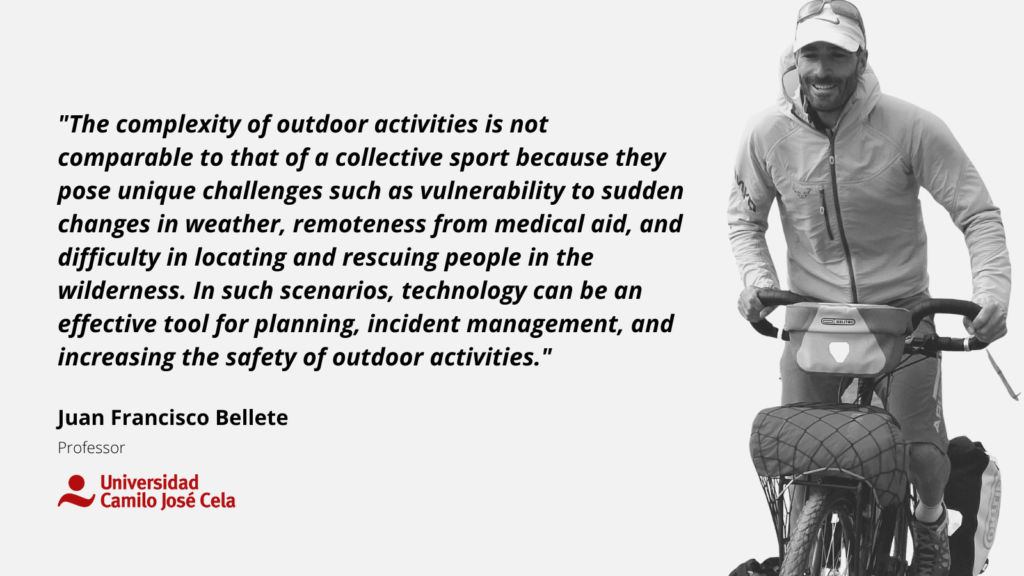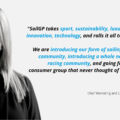26 Apr Have you met…Juan Francisco Bellete? – Exploring the Future of Active Tourism and the Role of Technology in Ensuring Safety and Enjoyment
Juan Francisco Bellete, Professor at Camilo Jose Cela Univerisity, Professor of intermediate training cycles, university professor in physical activity and sports sciences, manager in an active tourism company, technician, trainer and guide in training for sports technicians in horse riding, canyoning, climbing and mountaineering.
Question: Could you please introduce yourself and your role at the University Camilo José Cela?
Answer: My name is Juan Francisco Bellete, and I have been a professor at the University Camilo José Cela for the past ten years. My area of expertise involves leisure, free time, sports in natural environments, tourism, and sports. Although the classes touch upon these areas, the course falls under three different categories, namely tourism, sport, physical activity, and sports in natural environments, which are mandatory for obtaining a Bachelor’s degree in Sports Science. I also teach an additional course on sports and recreation. My interest in these subjects stems from my experience as the owner of a tourism company for the last 25 years. I have observed a growing demand for professionals in this field, which is why I try to align the courses to meet this demand.
Q: What is the demand like in the market that you specialize in? Is there a gap between the demand of the market and the education that the university offers? What are the job posts that need to be covered, and is today’s offer adequate?
A: The pandemic has increased the demand for physical activity in a natural environment and tourism. If we take Spain as an example, where tourism represents 10% of the economy, we can say that one out of every ten job opportunities is related to the tourism sector. When it comes to physical activity in natural environments, there are two types of people. The first type of person is motivated to organize and plan their trip, activities, and accommodations, with physical activity being their primary goal. The second type of person hires companies to plan these activities for them. Popular activities include surfing, mountain climbing, skiing, golfing, hunting, and boating. Our company focuses on professionals interested in low-impact activities. We require individuals who are capable of performing a range of sporting activities and disciplines, as clients typically book activities throughout the year. Our industry is primarily composed of small businesses, with billings ranging from €200 to €1.5 million, limiting the number of personnel we can employ. We need people who can be hired year-round and can provide a range of services to clients with varying needs, including children, executives, and team-building activities. Therefore, flexibility and the ability to understand both winter and summer disciplines are critical. While basic disciplines are covered in university courses, there is a gap between general knowledge and specialized technical knowledge. For instance, a climbing technician can lead clients on extensive climbing journeys, which is not covered in basic courses. In conclusion, there is a gap between the demand of the market and the education offered by universities.
Q: You have named different challenges in this area, such as the need to stop seasonal sports and do them whenever in order to grasp the interest of more people. Do you know if there are existing technologies or if technology can help to solve these types of problems? Do you know any solutions that can be implemented to help with security or de-seasonalization?
A: When we talk about security, there is a paradox of activities in the natural environment – both those solicited by a client to an active tourism company or an active tourism professional and those of athletes whose main motivation is to pursue the activity. The complexity of outdoor activities is not comparable to that of a collective sport like football in a stadium, where environmental exposure is limited. In contrast, outdoor activities pose unique challenges such as vulnerability to sudden changes in weather, remoteness from medical aid, and difficulty in locating and rescuing people in the wilderness. In such scenarios, technology can be an effective tool for planning, incident management, and increasing the safety of outdoor activities.
New technologies work differently and can provide many benefits for those engaged in outdoor activities. Planning is critical to ensure safety and maximize the enjoyment of the experience. Technologies like social media, risk maps, and virtual visits allow people to gather information on weather, terrain, and obstacles before embarking on an activity. For instance, initiatives like The North Face’s Power Further and Salomon’s 360-degree camera and virtual tour provide detailed information and insight into what people can expect during their climb or trek. These tools also motivate and inspire people to engage in such activities and plan better for them.
In case of an accident, technology can provide prompt assistance and support to those in need. Smartphones, smartwatches, and other wearable devices can track people’s movements, pulse rate, and position. Brands like Garmin and other smart sports watch manufacturers offer advanced features like global satellite connectivity, which allow tracking of the user’s location, pulse rate, and movement. This feature can help in detecting an accident and alerting emergency responders or a designated group of protectors, who can take immediate action and provide assistance. In areas where phone reception is poor, satellite-based communication systems are invaluable for emergency situations.
In summary, technology can be a valuable tool for improving safety, planning, and enjoyment of outdoor activities. It can provide useful information and data for planning, inspire people to engage in outdoor activities and provide assistance in case of an emergency.

Q: You have mentioned several challenges in the outdoor activities industry, such as the seasonal nature of sports and the need to generate year-round interest. Are there any existing technologies that can help solve these problems? What solutions do you think could address security concerns or de-seasonalization?
A: When it comes to outdoor activities, there is a paradox at play. On one hand, these activities are often solicited by clients looking to experience adventure, while on the other hand, they can be dangerous and require careful planning and preparation. Unlike collective sports like football, outdoor activities take place in a dynamic and unpredictable natural environment that presents unique challenges such as sudden weather changes, remoteness from medical aid, and difficulty in locating and rescuing people. In this context, technology can be a powerful tool for planning, incident management, and improving the safety of outdoor activities.
New technologies can offer many benefits to those engaged in outdoor activities. Effective planning is critical to ensure safety and maximize the enjoyment of the experience. Social media, risk maps, and virtual visits can help people gather information on weather, terrain, and obstacles before setting out on an activity. For example, initiatives such as The North Face’s Power Further and Salomon’s 360-degree camera and virtual tour provide detailed information and insight into what people can expect during their climb or trek. These tools can also motivate and inspire people to take part in outdoor activities and plan for them better.
If an accident does occur, technology can provide quick assistance and support to those in need. Wearable devices such as smartphones and smartwatches can track people’s movements, pulse rate, and position. Advanced features like global satellite connectivity, offered by smart sports watch manufacturers like Garmin, can allow the user’s location, pulse rate, and movement to be tracked. This can help emergency responders or designated protectors detect an accident and take immediate action to provide assistance. In areas with poor phone reception, satellite-based communication systems are invaluable in emergency situations.
In summary, technology can be a valuable tool for improving safety, planning, and enjoyment in outdoor activities. It can provide useful information and data for planning, inspire people to engage in outdoor activities, and offer assistance in case of an emergency.
.







